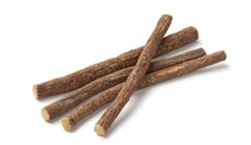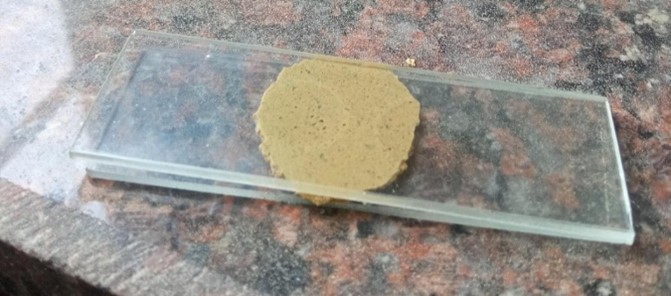The primary goal of this study was to create a polyherbal face scrub that included Nigella sativa (Kalonji) as the primary active ingredient. Natural ingredients are used in herbal cosmetics because they have the ability to prevent wrinkles and acne as well as assist regulate oil discharge from the skin by opening pores. The plant components used in herbal remedies and cosmeceuticals often include antibacterial, antioxidant, and anti-aging qualities. Because they have no negative side effects and don't alter the biological function of the skin, natural ingredients are the safest and greatest products to use in daily life. The active components in this face scrub mixture are Fuller's earth, Neem, Turmeric, Green tea, Kalonji, Liquorice, and Aloe Vera. The produced face scrub satisfied all necessary characterisation requirements after being assessed for look, pH, viscosity, spread ability, extrudability, grittiness, stability tests, foamability, washability, and irritability, among other factors. Therefore, this mixture may be effectively used as a face scrub to maintain skin that is radiant and healthy. Herbal compounds with antibacterial, anti-inflammatory, antioxidant, and anti-aging qualities are typically included in cosmeceuticals. The main goal of the current study was to create a polyherbal facial scrub using natural ingredients to protect and fight against various skin problems, such as acne, pimples, wrinkles, dark spots, black heads, and dark circles, as well as to control oil secretion on the skin's surface. Herbal cosmetics are among the safest products that can be used in daily routines without causing any side effects. Many cosmetics can cause rashes and dry skin when used topically. The use of a scrub made entirely of natural substances can solve all of these issues and improve the skin's washing, softening, moisturizing, and fairness. Cosmeceuticals are products that enhance skin function. Multani mitti were added to the polyherbal scrub's composition as active ingredients. Numerous parameters, including appearance, pH, viscosity, spread ability, washability, and irritation, are used to evaluate the polyherbal scrub, and the results are determined to be good. As a result, the created mixture works well as a scrub to support skin that is radiant and healthy.
Cosmetics come in a variety of forms and are used by people throughout to improve their appearance. For skin protection, sunscreen, anti-acne, and anti-wrinkle, a variety of skin problems are created. In the past, people used herbs or herbal cosmetics for washing, beautifying, and combating oil, acne, blackheads, pimples, and dark circles. According to Ayurveda, blood impurities are a primary contributor to skin issues. Face scrubs are cosmetic formulas that often come in the shape of a cream or gel with microscopic exfoliating particles in them. Face scrubs remove adhering cells in the stratum corneum and dead skin cells, which exfoliate the face, increase blood circulation, and accelerate skin turnover. Face scrubs preserve skin suppleness, clean the skin, extract oil, debris, and filth from pores, and hasten the skin's cell regeneration process. A face scrub should be mild abrasive, nonstick, non-toxic, and remove dead skin cells and grime. include tiny, non-irritating grit particles. Natural and herbal components work as a cleaning solution to remove dead and old skin cells from any kind of skin condition. The primary component in this recipe is orange peel powder, which has antibacterial and antioxidant qualities in addition to being high in vitamin C. The grit in powder aids in clearing the skin's pores and getting rid of dead skin. Another active component is fuller's earth, or Multani mitti. It is used as a natural astringent and cleanser and has several advantages for the skin, such as lowering oil production, combating acne, balancing and lightening skin tone, and lessening pigmentation. Because of its therapeutic qualities, sandalwood powder helps to reduce inflammation, eliminate scars, and purge the skin of impurities to leave the skin with a uniform tone. The antioxidant properties of turmeric may give skin a healthy shine and gloss. Honey acts as a natural humectant, which helps to keep the skin hydrated. It also contains antibacterial and antiseptic properties, which may be beneficial for oily and acne-prone skin. Additionally, moisturizing ingredients like aloe vera gel—which contains 80% water—along with a host of vitamins, minerals, and other nutrients help to create incredibly smooth, radiant skin. Glycerine helps moisturize skin, relieve dryness, and revitalize the skin's surface. Cosmetics are a blend of chemicals used for washing, beautifying, and attractiveness that come from synthetic or natural sources. Skin is a good indicator of one's health. Regular application of scrubs leaves skin smooth, velvety, radiant, and healthy as new skin cells are revealed and old skin cells are eliminated. One of the main components in the composition of the face scrub is a mild abrasive agent. Scrub may be applied directly to the skin or with the use of a little cosmetic pad. It is advised to massage the skin gently after applying the scrub, as this promotes better blood flow and an increased supply of oxygen to all areas of the skin. These days, the most common skin problems are acne and pimples, with dry skin, wrinkles, and dark spots coming in second. To get rid of all these skin issues on any kind of skin, scrub is utilized. Since the skin is the area of our body that is most exposed to bacteria, it needs to be protected against skin conditions, particularly those that cause acne. Eighty-five percent of the skin conditions that young people nowadays deal with are caused by acne. It may even worsen as one ages, affecting the face and neck in particular—areas where there is a severe lack of oil. Seborrhea, inflammatory lesions, comedones, excessive sebum production, and bacterial infections of the follicles by Propionibacterium acnes, Staphylococcus epidermidis, and Malassezia furfur are the most prevalent causes of acne. Therefore, it is possible to target these microbes for the potential therapy of acne. When long-acting antibiotics are used for medical purposes, living things become increasingly drug-resistant. This complex adaptability is influenced by a variety of factors, including the body's reaction to medication, hormones, stress, and other circumstances. Studies on alternative remedies have been conducted to address this issue. Herbal extracts were made into a polyherbal anti-acne face gel since they cannot be used directly as a therapy. The anti-acne and antibacterial properties of gels prepared with Hydroxy propyl methyl cellulose (HPMC) and Carbopol in different doses of herbal remedies were investigated in this study.
Cosmetics are items that are used to improve or alter the face's texture, scent, or look. A crucial step in the skin care routine is using facial washes. Typically, facial scrubs are cream-based products with tiny cleaning particles that, when applied to the skin, physically remove dead, dry skin cells to help smooth out the skin. Additionally, facial washes work wonders at maintaining the smoothness of the neck's skin, which facilitates cleaning. It will be simpler to use if you glance up when removing so that the neck skin is tight and smooth. A facial scrub is a fantastic deep cleansing treatment that is good for all skin types, but it works particularly well for oily skin. These neutral face scrubs are all effective in getting rid of extra oil as well as dirt and grime. This versatile mixture works well as a face mask or scrub. Blend with water, or give her a herbal remedy; apply to her face and gently wash. It will feel fresh, clean, and velvety on your skin. Your skin might feel smooth, vibrant, young, and lovely after using a face scrub. Facial scrubs, as opposed to regular soap or detergent, exfoliate the skin by removing dead cells and generating new ones through the application of tiny particles, beads, or chemicals. The simplest facial scrubs to use were those that involved selecting a neutral or chemical scrub that was appropriate for the skin type, massaging it for a minute on moist skin, and then cleaning it. Once or twice a week, repeat. Considering all its advantages, including face washes in your routine for taking care of sensitive skin. The process of skin peeling entails removing extremely old, dead skin cells from the skin's surface. All face problems require exfoliation, whether receiving chemical or microdermabrasion peels. Chemicals or machinery can be used to remove skin.
Selection of Scrub according to type of Skin
- Oily Skin
Due to the excess sebum oil clogging their skin pores, people with oily skin typically suffer from pimples. As a result, you require a face scrub that has anti-pimple qualities in addition to removing dead skin cells. Benefits of salicylic acid against acne are well recognized. Get a face cleanser with salicylic acid or other comparable anti-acne components if you have oily skin.
2.Dry Skin
Any face cleanser with components designed to eliminate dead skin cells is suitable for those with dry skin. One such component that readily eliminates flaky skin and dead skin cells is glycolic acid. It's a well-known excellent exfoliant. Seek for a glycolic acid-containing face scrub that also offers your skin some hydrating properties.
3.Sensitive Skin
Sensitive skin types need to exercise extra caution while selecting skincare products. Make sure the face scrub you use is antibacterial and anti-inflammatory if you have sensitive skin. Propylene glycol possesses antifungal and antibacterial properties. Yogurt and turmeric are two natural substances with anti-inflammatory properties. Scrubbing with sugar is said to be beneficial for delicate skin. Sugar is an excellent natural skin exfoliator that effectively eliminates dead skin cells.
4.Combination Skin
It might be challenging to select a face scrub for combination skin because it is a blend of dry and oily skin. However, experts advise using a face scrub that will remove excess oil from the skin without drying it out for those with mixed skin.
Difference between Face wash and Face Scrub
Smooth face washing is often performed with cream. In addition to cleansing, the grit on facial scrubs is utilized to exfoliate dead skin cells. Most doctors advise using simply face wash, not scrubs, if you have sensitive skin. Scratching can be facilitated by facial cleansers, which can irritate the skin. A face wash uses chemicals like soap to remove oil and grime from your face. Exfoliants like walnut shells or microbeads are used in facial scrubs to remove oil and grime from your face.
Benefits of Scrubbing Your Skin:
1. For A Squeaky-Clean Skin:
You may have clean, sweat-free skin after scrubbing off debris and oil. Actually, not all of the dust that builds up in your skin's pores can be removed by the bottles of cleaning milk, face wash, and cleansers. Scrubbing successfully completes this task.
2. Frees Your Skin from Flakes:
Itchy skin leads to dry areas. Over time, it permits dead cells to amass. You may successfully manage your flaky skin by giving your skin a good scrub.
3. Helps In Removing Dead Cells:
Dead cells give the appearance of worn, lifeless skin. Use a soft brush to gently clean them off.
4. Adds Glow to Skin:
Exfoliation has the ability to enhance skin glow.
5.Removes Dark Patches:
To see results, use the scrub twice a week. It works particularly well on knees, elbows, and knuckles.
6.Removes Acne Scars:
Exfoliation aids in the removal of acne scars.
7.Prevents Ingrown Hair:
Scrubbing is the best way to avoid the recurring issue of ingrown hair.
8. For Smooth Skin:
Having smooth skin is essential to becoming more attractive. Your skin will look immaculately smooth after the scrub, but it will also feel soft and nourished.
9.Improves The Texture of Your Skin:
Your skin seems cleaner, smoother, and has a better texture when you scrub it.
10.Promotes Clear Complexion:
as soon as the buildup of pollutants, dead cells, flake debris, and imperfections is eliminated. With a natural skin-whitening component in the scrub, the results are even greater.
MATERIAL AND METHODS: -
- Aloe Vera (Indian aloe)
Aloe vera does wonders for cuts! Its calming qualities can work in tandem with exfoliation to leave your skin feeling nourished and renewed. Aloe vera gel may be gently scrubbed to help remove dead skin cells and encourage a healthy shine. You can also combine it with sugar or oatmeal, two natural exfoliants.

Figure 1 Aloe vera
Botanical name: Aloe barbadensis
Common name: Kattarvazha
Kingdom: Plantae
Clade: Angiosperms
Clade: Monocots
Order: Asparagales
Family: Asphodelaceae
Subfamily: Asphodeloideae
Genus: Aloe
Species: A. Vera
Medical use:
Antioxidant, anti-inflammatory, and antimicrobial, treats acne and oily skin, reduce sebum secretion.
- TURMERIC (Haldi)
Turmeric is a common condiment and colouring ingredient. Turmeric's main benefit is skin revitalization. In addition to delaying signs of aging such as wrinkles, it also possesses antibacterial, antimicrobial, and anti-inflammatory properties. The greatest place to get blood purification. Turmeric works wonders for skin that is impacted by certain disorders. Rosacea and eczema are two skin problems that it can relieve.

Figure 2Turmeric
Botanical name: Curcuma longa
Common name: Malayalam: Manjal
Kingdom: Plantae (unranked): Angiosperms (unranked): Monocots (unranked): Commelinids
Order: Zingiberales
Family: Zingiberaceae
Genus: Curcuma
Species: C. Longa
Medical use: -
Antioxidant, anti-inflammatory, and antimicrobial, treats acne and oily skin, reduce sebum secretion Antiseptic and improves Fairness.
AMLA
Its high antioxidant and vitamin C content helps to minimize dark spots and hyperpigmentation. By scavenging free radicals in your skin cells, the antioxidant and other polyphenols in amla contribute to the natural lightening of your skin. Get rid of your suntan and sunburn. Sandalwood shields the skin from the damaging effects of the environment and maintains its cool, fair, and healthy appearance.

Figure 3 Amla
Kingdom: - Plantae
Class: - Dicotyledone
Order: - Malpighiales
Family: - Phyllanthaceae
Botanical Name: Phyllanthus emblica
Chemical Constituents: Chebulagic acid, Gallic acid, Ellagic acid
Genus: - Phyllanthus
Medical use: -
Anti-aging, treats acne, evens skin tone, treats ski pigmentation, removes dead skin, natural hair straightener
NEEM
Because of its well-known antibacterial and antifungal qualities, neem is a fantastic addition to DIY scrubs, especially for skin that is prone to acne. Neem powder may be used with other natural substances, such as yogurt, honey, or turmeric, to make a mild exfoliating scrub that helps remove dirt and bacteria that causes acne. Just use caution as neem may be fairly strong if you have sensitive skin.

Figure 4 Neem
Kingdom: - Plantae
Class: - Dicotyledonae
Order: - Sapindales
Family: -Meliaceae
Genus: - Azadirachta
Botanical Name: Azardicachta indica
Chemical Constituents: Azadirachtin, Nimbin, Gedunin
Cosmetic Uses:
Neem leaves are used to treat skin sores and leprosy. It has antibacterial and antioxidant characteristics that filter into the skin and eliminate all dirt and microbes. Some of its health improving properties are useful for acne, rashes, and skin infections.
KALONJI (Black caraway)
Kalonji, often referred to as black seed or Nigella sativa, has nourishing and exfoliating qualities that make it a useful ingredient for a scrub. To make a scrub, finely ground kalonji seeds and combine them with honey, yogurt, or olive oil.

Figure 5 Kalonji
Kingdom: - Plantae
Class: Nigelids
Order: - Nigella
Family: -Ranunculaceae
Botanical Name: Nigella sativa
Chemical Constituents: Thymoquinone, Linoleic acid
Medical use: -
Anti bacterial, prevent acne, antioxidant, fights hair fall, fights skin infections
LIQUORICE (Mulethi)
Because liquorice, also known as mulethi, has calming and whitening properties for skin, it may be used as a scrub. Ground liquorice root to a fine powder and combine with other ingredients (such as chickpea flour, honey, or rose water) to prepare a paste to use as a scrub.

Figure 6 Liquorice.
Kingdom: - Plantae
Order: - Fabales
Genus: - Glucyrrhiza
Family: - Fababacea
Botanical Name: Glycyrrhiza glabra
Chemical Constituents: Glycyrrhizin, Liquirtin, Anethole
Cosmetic Uses:
Brightens skin, hide sun damage, fade dark scars, treat skin condition, ease inflammation, firm and tightens skin, treat acne
FULLERSEARTH (Multani mitti)
Multitani mitti has several advantages, including as pore reduction and blackhead eradication. Enhancing blood circulation. They provide skin with a healthy shine and decrease acne since they are packed with essential nutrients. Multani Mitti has an abundance of magnesium chloride.

Figure 7Fullers Earth
Botanical Name: Bentonite Clay
Chemical Constituents: Hydrous aluminum silicates, Calcite
Medical Uses:
Oil and impurities absorber, provide fairness and glow, fights acne and pimple.
Rose water
Rose water has several applications, including relieving skin irritation, reducing skin redness, soothing sore throats, healing wounds, scars, and burns, improving mood, relieving headaches, having anti-aging qualities, and easing digestive issues. It also includes antioxidants.
Kingdom: - Plantae
Family: - Rosaceae
Order: - Rosales
Genus: - Rosa
Class: - Angiosperms
Use: -
For a number of reasons, rose water may be an excellent complement to a face scrub. It is well renowned for its calming qualities, which make it perfect for delicate skin. Additionally, it has antibacterial and anti-inflammatory qualities that help combat acne-causing germs and reduce redness and irritation. Rose water also gives the scrub a beautiful scent that improves the whole experience. Just be careful not to be allergic to rose water, and always do a patch test beforehand.

FORMULATION TABLE:


 Amar P. Ghodke*
Amar P. Ghodke*
 Vidya R. Kale
Vidya R. Kale
 Vishal V. Bhise
Vishal V. Bhise















 10.5281/zenodo.11609810
10.5281/zenodo.11609810